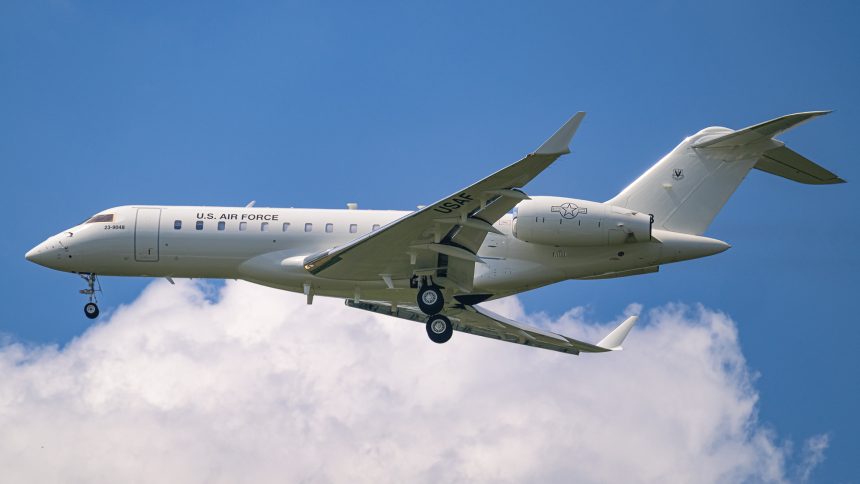We had the unique opportunity to interview the pilot of the E-11A Battlefield Airborne Communications Node (BACN) aircraft during its first airshow appearance at the recent Seymour Johnson Air Force Base Open House.
The airshow at Seymour Johnson AFB, North Carolina, is high on the list of many airshow enthusiasts, when planning their yearly schedule of shows to attend. Certainly, one of the features of the show are the four F-15E Strike Eagles from Seymour Johnson’s own 4th Fighter Wing. They perform the Combined Arms Demo with participation from two T-38 Talons, of the 14th Flying Trainer Wing, at Columbus AFB, Mississippi. This twenty minute demonstration with pyro and an abundance of flares from the Strike Eagles, makes for a gripping display of military capabilities, featuring the integration of air and ground forces.
While the Combined Arms Demo was captivating from a flying perspective, what really captured our attention was the list of static aircraft making an appearance at this year’s open house. Two heavy bombers, a B-1B from Dyess AFB, Texas and a B-52H from Barksdale AFB, Louisiana were enthusiastically greeted by the crowd. In addition, an RC-135W Rivet Joint ISR (Intelligence Surveillance Reconnaissance) aircraft, serial number 62-4125, from Offutt AFB, Nebraska, made a rare public showing as well.
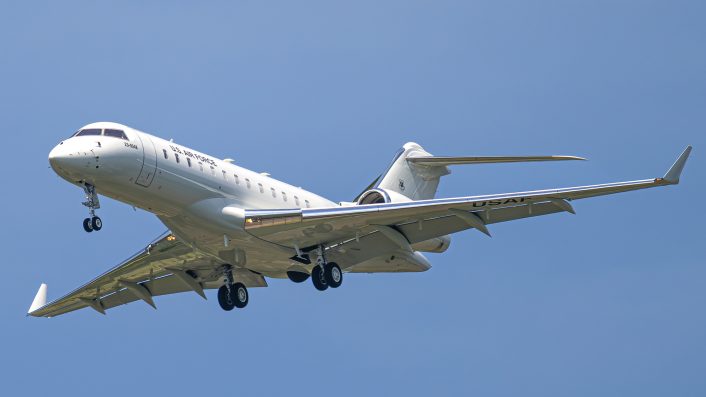
However, it was the inaugural display of the E-11A BACN aircraft, serial number 23-9048, from Robins Air Force Base, Georgia that was the real surprise of the airshow.
What makes the appearance of the E-11A at the Seymour Johnson Open House special, and what exactly is the function of this secretive and highly sought after aircraft?
Firstly, let’s review the airframe of the E-11A. The E-11A is a modified Bombardier Global Express 6000/BD700 business jet. The modification made to the jet consists of Northrop Grumman’s Battlefield Airborne Communications Node, (BACN).
According to Northrop Grumman BACN program director:
BACN combined with the E-11A modified Bombardier BD700, enable a high-altitude, airborne communications gateway that translates and distributes imagery, voice and tactical data from disparate sources. This results in enhanced situational awareness and enabling seamless interoperability for joint and coalition forces operating across air, space, land and sea. The open architecture design and cyber-secure processing of the BACN Gateway system, coupled with its ability to easily integrate advanced technologies and proven track record of success, make this system well-suited to meet the needs of Joint All Domain Command and Control.
BACN is currently carried on six E-11As, and the seventh and final aircraft will be delivered by the end of 2025. BACN is a key command and control facilitator supporting airdrops, personnel recovery, convoy, humanitarian assistance and close air support operations. Northrop Grumman builds and maintains the BACN payload as well as the platform, and trains Air Force personnel”.
There are many advantages for using the well established Bombardier BD700 Global Express business jet for the E-11A BACN. Firstly, the Global Express is a business jet with a strong track record of reliability. This is an edge for the maintainability of the E-11A. Secondly, the long range (6000 nmi) and high altitude (51,000 ft.) of the BD700 allow operation of the jet for extended periods, over considerable distances, at altitudes that allow the E-11A to operate optimally for communications and data transmission. Lastly, the BD700 has a spacious interior which allows for the installation of the E-11A’s sophisticated communication and data processing systems.
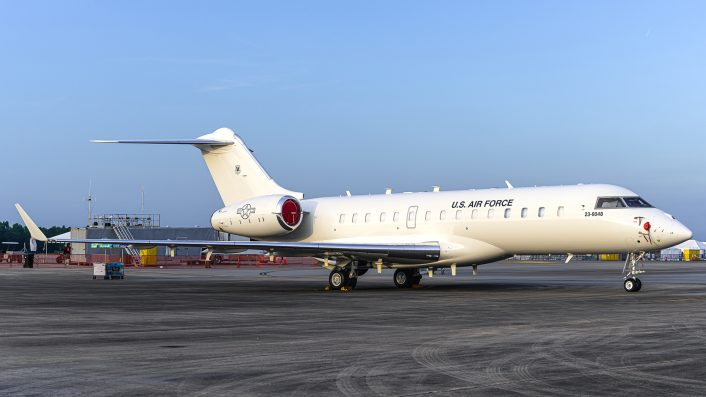
Facts regarding recent missions flown by the E-11A are scarce, though The Aviationist has published details involving the role of the E-11A in coordination for humanitarian airdrops over Gaza in March of 2024. According to a report in Air & Space Forces Magazine, “The E-11A has supported a total of 33 U.S. airdrops into Gaza, fulfilling the mission each time”. In addition, details were revealed involving the E-11A participating in an exercise in the Arabian Peninsula. The E-11A acted as a communications hub linking up many different systems used by coalition forces, as they participate in Counter-Drone and Integrated Missile Defense, in the Middle-East.
The BACN system achieves seamless integration across differing systems by acting as a real-time data translation and relay node. It takes dissimilar military radios, waveforms and data protocols (e.g., Link 16, EPLRS, SADL, UHF/VHF, SATCOM) and acts as a middleware translator, converting incompatible communication formats into a common, understandable format. BACN links voice communications across incompatible systems, enabling direct communication, with airborne and ground forces as well NATO allies with different radio equipment.
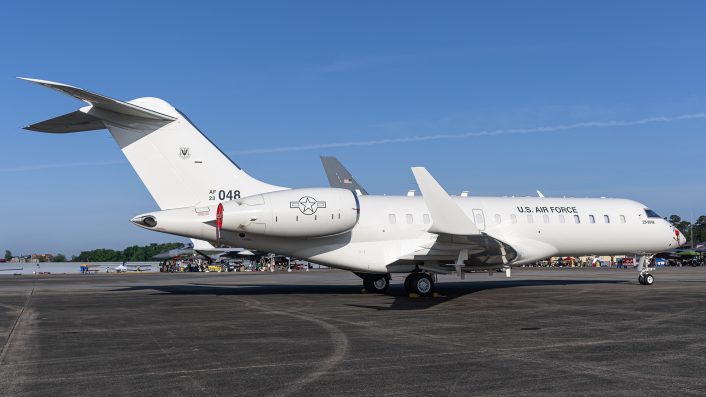
There are still many facets of the E-11A operations that remain unanswered, or are found to have limited available data. Items such as, squadron reporting structure, forward basing of aircraft, operational details of past missions, payload configurations, the future role of the E-11A, are just a few of the topics that need more clarity.
Given that there are unresolved queries, it became a priority to take advantage of the E-11A appearance at the Seymour Johnson Open House, to seek some answers. Thus, with the help of the 4th Fighter Wing Public Affairs Office, at Seymour Johnson, and with an ample amount of ground rules in place for allowed questions. The Aviationist was able to secure a very rare opportunity to interview the pilot of the E-11A, as the jet sat on the static display ramp, airshow weekend.
Captain Vic Savino, an E-11A pilot from Auburn, Washington, was able to spend some time with The Aviationist and answer questions related to his flight career, the operation of the E-11A, and its function.
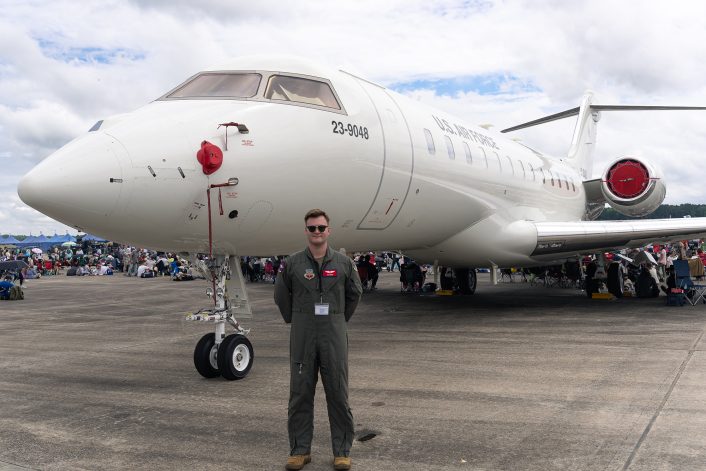
Question: What aircraft did you fly prior to the E-11A?
Answer: My first assignment was with the E-8C Joint Stars at Robins Air Force Base. Then I moved on to the E-11A also at Robins Air Force Base in Georgia.
Q: Okay, thanks for that. How many total flight hours do you have and how many flight hours in the E-11A?
Total hours are 1,900 and 800 hours in the E-11A.
Can I have clarification on what squadron you report into?
Yes, so the aircraft flies for the 18th ACCS (Airborne Command and Control Squadron) out of Robins Air Force Base. Well, actually, formerly the 18th ACCS. On May 1, 2025, we changed: we are now the 472nd ECS (Electronic Combat Squadron), also, out of Robins Air Force Base.
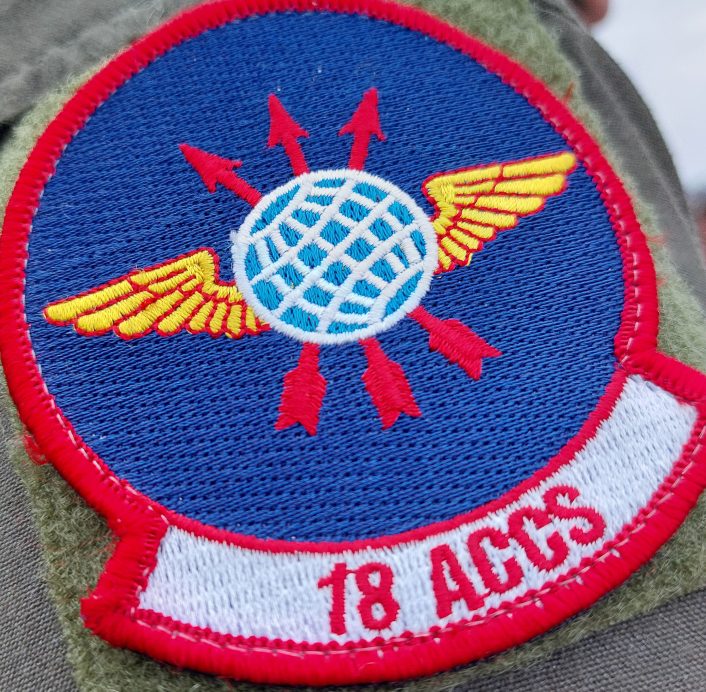
Will the new 472nd ECS report into the 319th Reconnaissance Wing at Grand Forks AFB, North Dakota, same as the 18th ACCS did?
As far as I know, Yes.
It is quite unique having an E-11A at an airshow. Is this your first ever airshow for the E-11A?
Yes, it is.
Is there a reason why you chose this airshow at Seymour Johnson to bring the E-11A to, and will there be other shows you will attend?
I am not exactly sure on the background, as to why we came to this specific airshow, and do not know yet if there will be other shows that we will attend.
How many E-11A aircraft do you currently have in the squadron, and what is the target number of aircraft for the future.
Future operations, I can’t really talk about that, also, I am not really sure. Currently, I believe we have 6 aircraft.
Let’s talk a bit about the unique role of the E-11A and what its purpose is.
Sure, so this aircraft has the BACN package, (Battlefield Airborne Communications Node). This package has been in different platforms. It was previously in the RQ-4 Global Hawk. Since 2008, it has been in the E-11A. The package, (also called payload), consists of several types of radios and data link equipment in the aircraft. The equipment is remotely controlled from a ground station out of Robins AFB, or forward locations. [Author note: Remote control of equipment is performed by the Payload Operators)].
So, what this package does is if you have one type of radio that is on an airplane or at a ground station that normally would not be able to talk to another type of radio or communication system, essentially it can go through us as a gateway to bridge these two communication sources together.
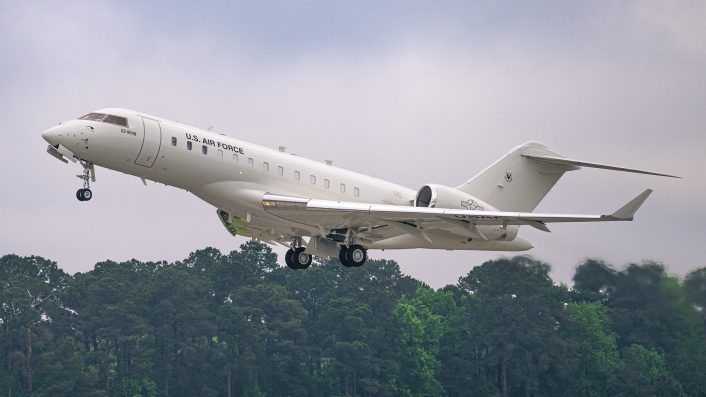
You mentioned forward locations. Is that the standard for E-11A’s, that some are always forward deployed?
Well, they could be anywhere in the world, so yes, they could be forward deployed.
Can you mention any recent real world missions that you participated in and why the E-11A was chosen for that mission?
I can’t really go into specifics on recent or past missions.
Do you work with the Combined Air Operations Center for mission guidance?
Yes, they serve us the same way that they serve other aircraft in theatre. We liaise with them to provide the whole big picture of what’s going on in theater
Okay got it. Let’s shift gears here. How many crew are aboard the E-11A?
There are two pilots aboard.
On a typical mission, how many specialists or mission crew (not including the 2 flight crew are aboard the aircraft?
Typically, the mission specialists do not fly on the aircraft, unless it is being re-positioned away from home station, in which case, one may be aboard. Several payload engineers, and network engineers configure the payload on the airplane while it is on the ground, while several other (maybe 2-3), payload operators, control the payload from the ground, during operations.
Lastly, what can the E-11A do that other aircraft can’t?
Well, the platform is a Bombardier Global Express 6000/BD700-1A10 business jet. Its range is approximately 6,000 nautical miles. Thus, fully fueled it can fly for over 12 hours. No need to refuel the jet, so that drives down a lot of costs and logistical complications for the mission that we do. In addition, the reliability of the airframe is very good and they are relatively new.
Captain Savino, thanks very much for taking the time to talk with us today.
My pleasure.
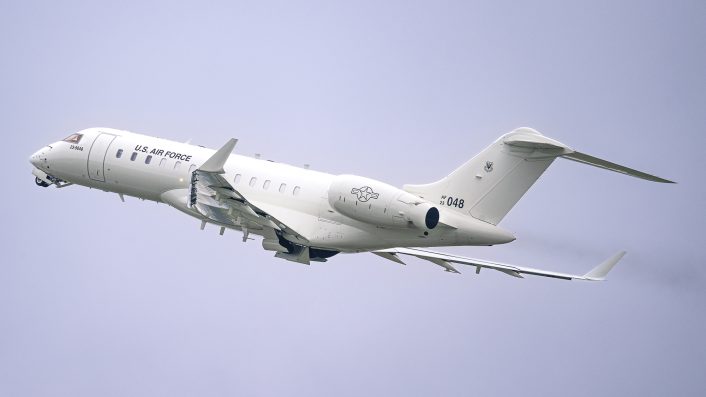
The Aviationist would like to thank the 4th Fighter Wing Public Affairs Office, Seymour Johnson Air Force Base, including 2nd Lt. Jason D. Pannell, Capt. William Gomez, and SSgt. Sean Martin.
Special thanks to Captain Vic Savino from the 472 ECS, Robins Air Force Base.

